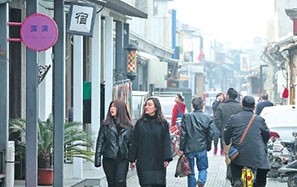China monitors air pollution with 'eyes' in sky
BEIJING - Scientists will be able to better monitor haze and air pollution that chokes cities like Beijing after the launch of a high-resolution earth observation satellite.
China is stepping up its use of remote sensing technology and will analyze data from satellites sent into orbit to get more comprehensive and accurate information about its air pollution, according to scientists attending the ongoing 35th International Symposium on Remote Sensing of Environment in Beijing.
The satellites have been sent by China, the United States and Europe.
Li Zhengqiang, a researcher with the Institute of Remote Sensing and Digital Earth of the Chinese Academy of Sciences, said, "The new satellite Gaofen-1 is the first one of China's high-resolution system for earth observation. And one of its purposes is to monitor air pollution."
The country plans to launch five or six such kinds of satellites before the end of 2015.
"The satellite will be very useful in monitoring haze. Through it we can observe the distribution difference of haze in Beijing's urban area, and we can find out more details of the haze," said Li, who is researching atmospheric PM2.5 using high-resolution satellites data.
Beijing has suffered from haze since the beginning of the year.
Another researcher, Xue Yong from the Institute of Remote Sensing and Digital Earth gave an oral report on the remote sensing of the prolonged haze in January in Beijing at the symposium. "Our research on remote sensing aerosol particles started more than a decade ago. Beijing has haze every year, but this year's situation is the worst. From the satellite images, we can see the range of the haze over Beijing increased. And haze appeared in some regions of China where it had never been found before," Xue said.
"The goal of our research is to get the total volume and the distribution situation of the aerosol particles in China. At the same time, we focus on the observation of metropolises like Beijing and Shanghai. We hope to analyze the physical components of the haze, such as the density of PM2.5, through remote sensing technology, when serious air pollution happens," said Xue.
Haze usually covers a large area. Therefore, using remote sensing technology allows for full knowledge of the changing process of the haze, according to Xue.
Currently, ground observation of the haze is the most accurate method. However, it depends on observation points. If two points are too far away from each other, the pollutant particles may change a lot between the two points and cannot be observed, Xue said.
"Remote sensing data can show the overall haze situation. We can combine the remote sensing and ground observation to get more accurate information," Xue added.
Chinese scientists analyze data from a number of satellites launched by China, the United States and Europe. Each satellite has its own merits. The sensor of a European satellite can analyze the atmospheric components, although its resolution is not high. A satellite of the United States carry out three-dimensional observation of the distribution of aerosol particles, but only within a narrow area that the satellite flies over.
Experts said it is still hard to use remote sensing technology to carry out quantitative analysis of the physical contents of haze.
"Remote sensing technology cannot distinguish the size of the pollutant particles. So we combine the remote sensing data and meteorological observation data to improve the monitoring of PM2.5," said Li Zhengqiang.
He said the ground observation stations can only monitor PM2.5 several meters above the ground. But the distribution of haze changes dramatically with the change of height.
"Using remote sensing technology we can find out the vertical distribution of the haze, and form a three-dimensional air pollution monitoring system," Li said.
Beijing aims to decrease the average density of main air pollutants by 2 percent in 2013. "In order to achieve the goal, we have to do more accurate monitoring of air pollution. A three-dimensional remote sensing monitoring system will play an important role in determining the degree of pollution, analyzing the source of the pollutants and making a decision on pollution control," Li added.
- Guangxi to tackle heavy metal pollution
- The case for Common Law reform against air pollution
- Smoking, air pollution major health threats in China
- China urges zero pollution in marine projects
- Authority clamps down on pollution
- Official apologizes over polluted river
- Apology for China's polluted 'milk' river

























